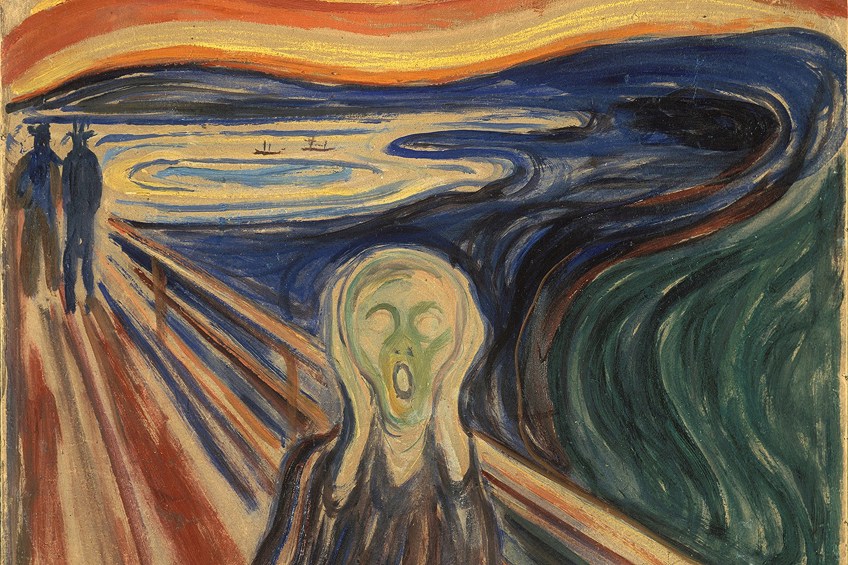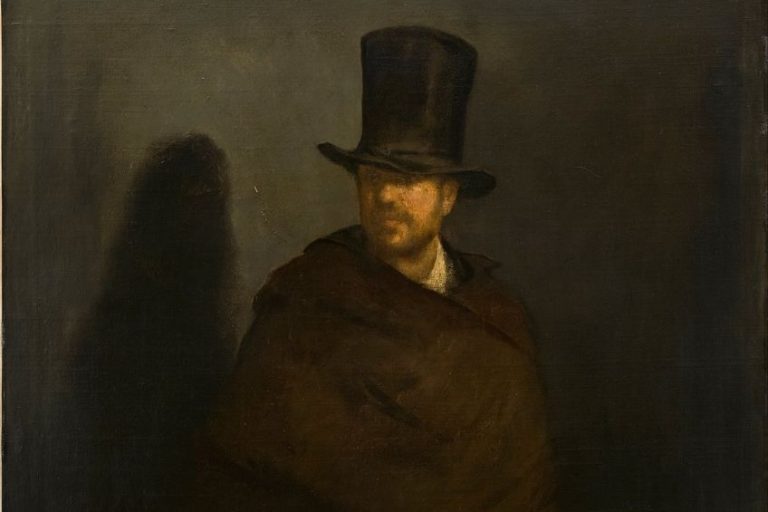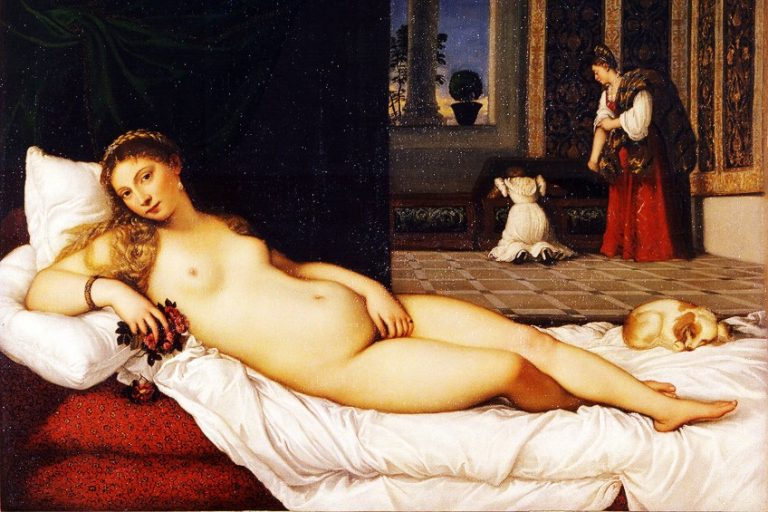“The Scream” Edvard Munch – Analyzing the Famous Scream Painting
Sometimes everything feels so overwhelming you just want to scream. We can all relate to these primal feelings of being human. Art has long been a source of solace for many to express the complexities of human life that are unutterable; there are countless examples. But there has been one painting that still stands out and loudly proclaims itself; this is The Scream by Edvard Munch, which is what we will discuss in the article below.
Table of Contents
Artist Abstract: Who Was Edvard Munch?
Edvard Munch was born in Norway in the Løten municipality in a village called Âdalsbruk on December 12, 1863, he died on January 23, 1944. He started art from a young age and struggled with various health problems growing up. His mother and sister both died of Tuberculosis and his father was strictly religious and suffered from anxiety or depression, which ultimately impacted Munch’s outlook on life and death. Munch studied at the Royal School of Art and Design (The Norwegian National Academy of Fine Arts). He was also greatly influenced by the views of Hans Henrik Jæger, an anarchist and writer, and the art styles of Impressionism and Post-Impressionism.
Munch was known for living and expressing himself as a bohemian.
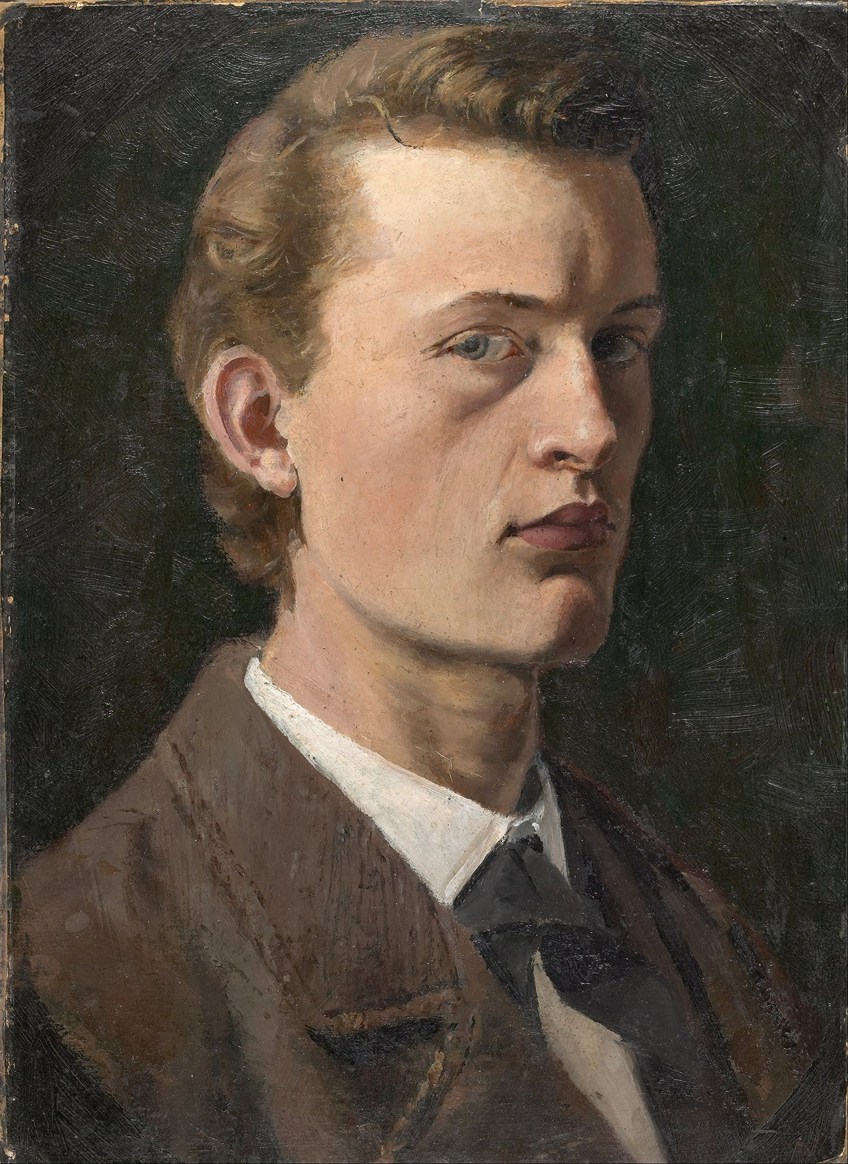
The Scream (1893) by Edvard Munch in Context
The famous Scream painting by Edvard Munch has long been one of the Norwegian artist’s seminal artworks, touching on the deep trenches of human existence and spirituality. Below we will provide a The Scream analysis and also discuss the question, “When was The Scream painted?”.
We will start with a contextual analysis and how The Scream painting developed and is part of a larger series by Munch called the Frieze of Life. We will then discuss a formal analysis by looking closely at the subject matter, color, and other stylistic elements that make up The Scream.
| Artist | Edvard Munch |
| Date Painted | 1893 and 1910 |
| Medium | Oil, tempera, and pastel on cardboard, including a lithograph |
| Genre | Genre painting |
| Period / Movement | Expressionism, Symbolism |
| Dimensions | 91 x 73.5 centimeters |
| Series / Versions | Belongs to the Frieze of Life series There are four versions and one lithograph |
| Where Is It Housed? | The 1893 version is at the National Gallery in Oslo, Norway The 1910 version is at The Munch Museum in Oslo, Norway. |
| What It Is Worth | Pastel on board version (1895) sold for around $120 million in 2012. |
Contextual Analysis: A Brief Socio-Historical Overview
It is important to remember that the famous Scream painting, the one we all have come to know, is most probably the 1893 version made from tempera and crayon media on cardboard. There are four versions of The Scream painting that Munch made.
His earlier versions were done in 1893, and both are currently in Oslo, Norway. The one that was made in pastel is housed at the Munch Museum and the other in tempera is housed at The National Gallery. Some believe the pastel version could have been a preparatory sketch for the painting.

The 1893 painting also has a barely visible inscription written in pencil that reads, “Kan kun være malet af en gal Mand!”, which means “could only have been painted by a madman”. There has been debate over whether this was written by Munch himself, but the curator at the National Museum, Mai Britt Guleng, studied Munch’s handwriting extensively and reported reasons why it was true.

Guleng reported that “Firstly, the handwriting is identical. I have word by word and letter by letter compared the sentence in The Scream with his handwriting in other notes and letters”. Furthermore, Guleng adds that “Munch also did not paint over it to conceal it”. The inscription is believed to have been written a couple of years after the painting was completed.
The other pastel version was completed in 1895 and the other painted version was completed during 1910. He also created a lithograph in 1895.
The Frieze of Life Series
The Scream painting itself was made as part of a series of other paintings that comprised The Frieze of Life series. The series reportedly consisted of around six paintings that now comprise 22 paintings. Some of the well-known paintings from this series include The Sick Child (1885), Love and Pain (1893 to 1894), Ashes (1894), Madonna (1894 to 1895), and others.

The main themes underpinning this series include the common spectrum of difficult human emotions and states that range from sex, sexuality, jealousy, anxiety, infidelity, separation, love, despair, and then also aspects related to women and their portrayal. Life and death are additionally large themes Munch explores too and we will see this is an underlying thread in his work.
It Started With a Walk
Now that we know some of the backstories of where the famous Scream painting fits into the larger body of Munch’s art oeuvre, how did it all start? Why did Munch paint The Scream specifically? Let us look at his diary entry from 22 January 1892 when he wrote:
“I was walking along the road with two friends – then the Sun set – all at once the sky became blood red – and I felt overcome with melancholy. I stood still and leaned against the railing, dead tired – clouds like blood and tongues of fire hung above the blue-black fjord and the city. My friends went on, and I stood alone, trembling with anxiety. I felt a great, unending scream piercing through nature”.

It is important to note that there are several different translations of what Munch wrote; some utilize the verb “passing through nature” and others “tear through nature”. Whichever translation is most accurate, the essence of what Munch described in his entry points to a vastness of life that seemingly goes beyond our understanding as human beings.
A vastness of nature that seems so enveloping that some feel it more than others. Undoubtedly Munch felt this on a deep, visceral, level.
The Scream: Volcanoes and Ashen Sunsets
You are probably wondering, where does the volcano fit in? Edvard Munch, who painted The Scream did not paint a volcano in the composition – let us elaborate. There is a body of research about where and when the possible scene of The Scream painting took place. Many scholars have questioned the blood-red sky that Munch painted, and if we look at his diary entry from above, he described that “all at once the sky became blood red”.
According to scholarly research, some have thought that Munch referred to an Autumn sky, but others have gone as far back as 1884 when Munch found the inspiration for The Scream, including a few other paintings. Apparently, he relayed this message to a friend when he was in Nice, a city in France, from 1891 to 1892.

In 1884 Munch lived in Kristiania, which is now Oslo, the capital of Norway. The volcano on the Krakatoa Island in Indonesia erupted in 1883 and left a significant impact on the rest of the world, as far as places in the Northern Hemisphere. The effects from the volcanic ash were visible in the skies, making blood-red sunsets, which became the subject for paintings too.
Whether it was a sense of awe for the reddened sky that triggered Munch’s deeper sensibilities that made him tremble with anxiety or whether it was just a moment of anxiety that overtook him, either way, this phenomenon awed many, including Munch.
Munch and Mummies
The research from art historian Robert Rosenblum has been widely referred to. He postulated that Munch may have found inspiration from a Peruvian mummy to portray his central figure in the painting. The mummy was thought to have been seen when Munch visited an ethnographic museum in Paris or at the World’s Fair in 1889, otherwise referred to as the Exposition Universelle. The mummy’s position was of significance as its hands cupped each side of its face, resembling the figure we see in The Scream painting.

There have been speculations over whether the above was in fact true and it is easy to make an art historical assumption since there is a visible resemblance between the mummy and Munch’s figure.
Munch Paintings: A Matter of Thievery
The Munch paintings have also been stolen on a couple of occasions, the first was in 1994 at the National Gallery and the second was during 2004 at the Munch Museum. The painting was retrieved from the thieves with no sign of damages incurred to it. The second theft involved an armed robbery and it included Munch’s other artwork titled Madonna (1894). Both artworks were found almost two years later in 2006 with minimal damages incurred to them.
Formal Analysis: A Brief Compositional Overview
Below we will examine the famous Scream painting that so aptly expressed an inner world of swirling emotions and states of being that Edvard Munch undoubtedly experienced. A subject of a painting that has become near and dear since its production.
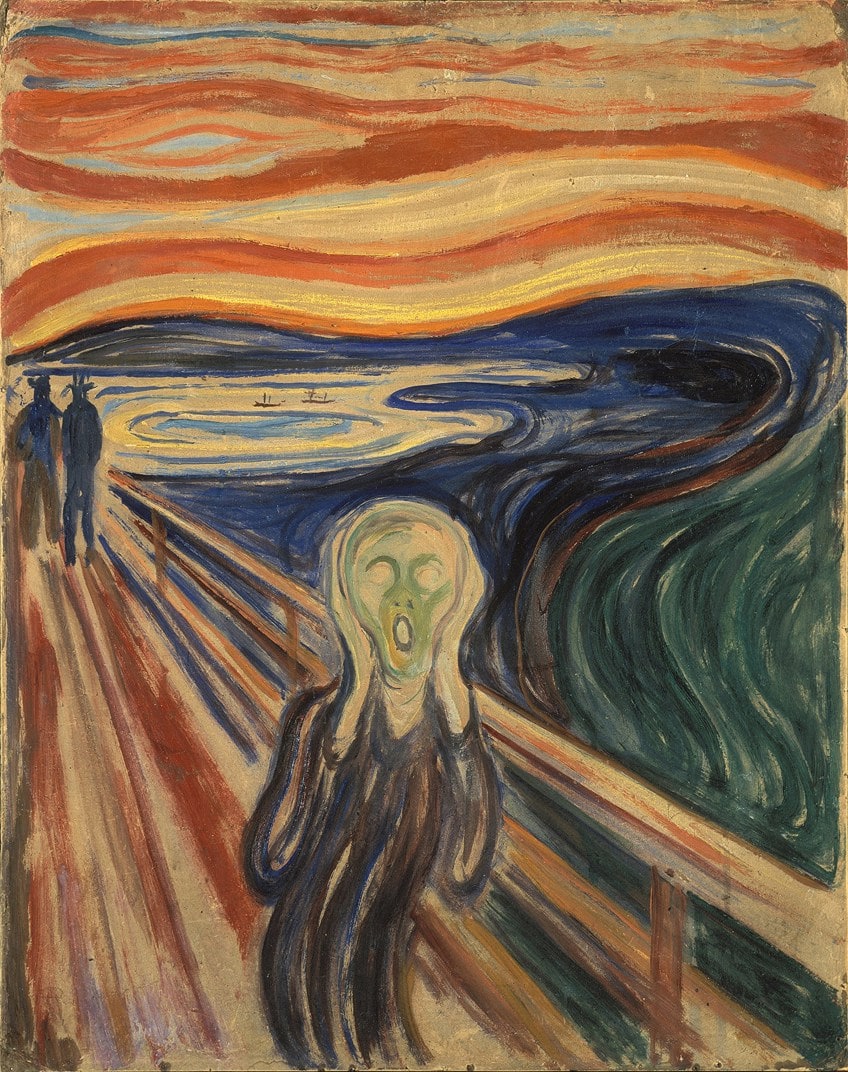
Subject Matter
When looking at The Scream, Edvard Munch depicts his main character in the central foreground, standing with his or her hands cupping the side of their face with their mouth agape in what appears to be either terror or awe, or both?
This figure has also been described by various sources as “sexless”; we are not sure if this is a male or female.
However, many sources suggest that The Scream is autobiographical, and the central figure could be Munch himself if we recall his accounts from his walk with his friends in Kristiania in 1884. Behind this central figure, or Munch, there are two other elongated figures walking the other way, their backs facing both us and the central foreground figure. They are not entirely recognizable, but they seem to be wearing hats and dark-colored outfits.

All the above-mentioned figures are on a bridge, which enters our visible space from the bottom right corner of the composition reaching towards the far background and out of our viewpoint. The bridge fills up the left side of the composition.
We can see how Munch utilizes the elements of perspective to create a sense of space and distance. The two men walking away from us are placed near the endpoint of the bridge as it extends out of our view.
Towards the right side of the composition, we see a vast swirling landscape with a body of water comprising the middle. There are hills in the distance and what appears to be an embankment to the right of the composition. In the far background, we will also notice what appears to be two boats on a body of water. Munch is possibly portraying a fjord, which is a common geographic formation in Norway.

Color and Brushstrokes
In The Scream, Edvard Munch utilizes color and brushstrokes beyond the traditional applications we would expect from these mediums. He connects the significance of various colors with the expressive and flowing nature of his brushstrokes.
We will notice the dominant colors are reds, oranges, greens, blues, browns, and various hints of blacks. Additionally, the colors are not overwhelmingly bright and Munch provides a scene with earthy tones.
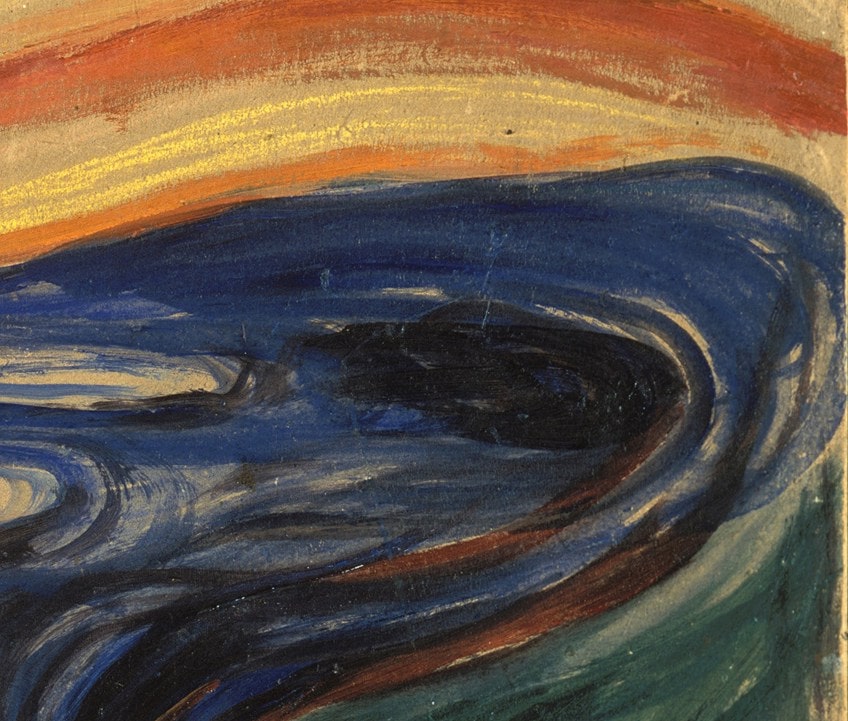
The sky makes up a large horizontal swathe of reds and oranges and appears to visually dominate the rest of the colors, which are more subdued. The landscape underneath the sky is depicted in more earthy tones like blues for the water, green for the hill, and browns for the bridge. The central figure in the foreground is painted with off-yellow shades that make it appear almost sick in appearance.
There are various contrasting colors in this composition and Munch utilizes complementary colors too; however, he applies these beyond the ideas of reality and puts greater emphasis on his internal state through color.
Line and Brushstrokes
Similarly, Munch utilized a strong sense of line in The Scream painting, and coupled with his swirling brushstrokes, again he emphasizes his internal state rather than the external. The entire composition is a swirl of colors, and the brushstrokes applied in this manner create an emphasis on the linearity of the painting.
There is a contrast between curves and straight lines. This is evident in the straight lines from the bridge and the two figures near the background walking away, which is offset with the strong curvilinear lines from the figure in the foreground and most of the composition on the right.
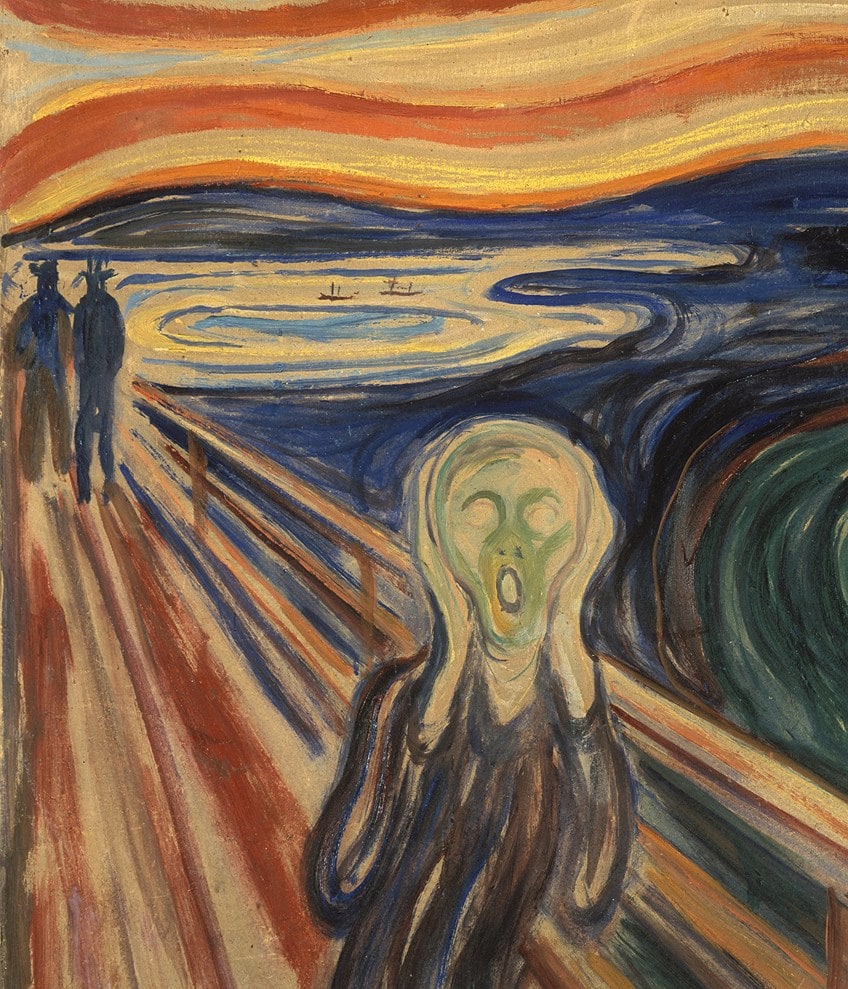
The body of the figure in the foreground does not appear the same as the figures behind it, in fact, it does not have an exact resemblance to a human body – it almost appears more like a scepter on the bridge. This is visible in the manner Munch portrayed its lower torso, we would expect to see two legs, but here it seems like one shape unless the figure is wearing a robe that covers its legs.
These are all conjectures towards finding Munch’s meaning behind this figure.
However, as mentioned before, this figure was most probably created to symbolize an internal state that Munch felt and not so much his external appearance of how he looked on the bridge with his friends behind him. In other words, Munch becomes a sort of personification of anxiety or despair.
Popular Culture: The Scream Face
The central figure that undoubtedly gives life to Munch, who painted The Scream, and his oeuvre has become a symbol in popular culture. It has caused quite the sensation in films, television series, books, art, and our 21st-century social media emojis.
For Horror fans, the popular film Scream (1996), which spans four films in the franchise, will never be forgotten as its primary icon was the white mask that resembles the face we have come to know from The Scream by Edvard Munch. This mask is called the “Ghostface” Halloween mask and was utilized in the film, but it drew inspiration from Edvard Munch’s The Scream.
The Home Alone (1990) film also borrowed the iconic expression from The Scream face, which we can see when the main character poses for a poster of the movie with both his hands cupping his face in a sense of terror.
The Scream painting has also made an appearance for book covers that cover psychological issues, for example, The Primal Scream, Primal Therapy: The Cure For Neurosis (1970) by Arthur Janov. In contemporary art we will see The Scream recreated by various artists, for example, Andy Warhol who was mostly known from the Pop Art movement produced silkscreen prints of The Scream painting.
Warhol was in awe of Edvard Munch’s artwork and has been described by the International head of Prints and Multiples from the esteemed art and auction company Christie’s that “Warhol came to this imagery as a function of his respect for Munch, not only as an artist but as a printmaker”. Both Andy Warhol and Edvard Munch had printing in common, and Munch also started reproducing The Scream through the lithograph he produced in 1895.

Other artists include the Icelandic Erró, who painted the Postmodern The Second Scream (1967) and Ding Dong (1979) in acrylic paint. Both paintings were produced as parodies of The Scream by Evard Munch. The Second Scream depicts a similar setting from the original only here Erró places another figure next to the screaming figure who joins in on the screaming, so to say. In the background, there is also an airplane flying into the foreground in our direction.
In Ding Dong, Erró replaced the fjord in the background with what appears to be a schoolyard with several children playing on a field, a woman in the background, possibly a teacher, and a building towards the far-right background, which is possibly the school building.
There is a large brass bell on the top of the building, it appears in the process of ringing, which could be indicating that playtime is over. This is emphasized by the large words, “DING DONG” placed in the middle of the composition in a white pointy-edged speech bubble.
If we look at Munch’s screaming face in this context, it takes on a different meaning, and a somewhat humorous one at that.
Bohemian at Heart
Munch lived an interesting life, he experienced mental and emotional hardships that he managed to translate through his artworks. He has often been described as a bohemian and had drinking problems that undoubtedly exacerbated his anxiety and depressive states. However, during the early 1900s, Munch stayed at a mental institution where he found a sense of relief and recuperation from his life of excess.
When he left the hospital after eight months, he was reportedly in a healthier state of mind and his lifestyle changed for the better, so did his artwork. He started painting landscapes and farming scenes. Apparently, he painted in lighter tones and his themes moved away from the darker and somber themes of death and despair. Some examples include The Sun (1911) and Spring Ploughing (1916), among others.
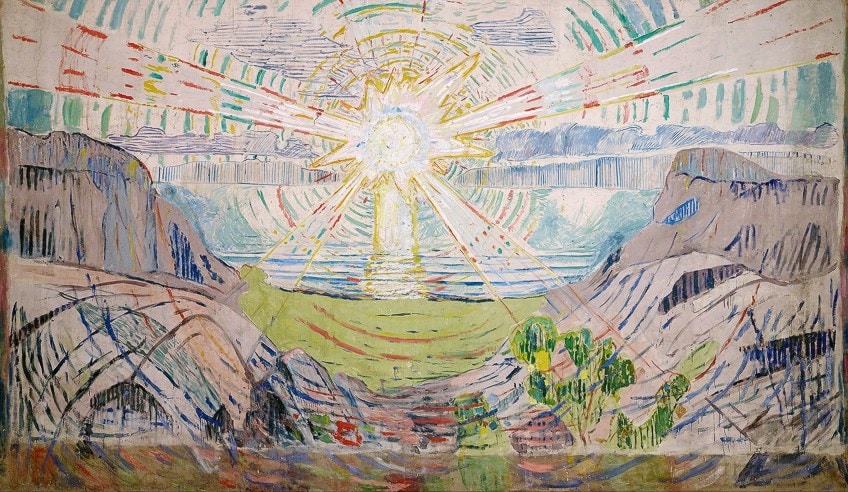
In “The Scream” analysis above, we learned that Edvard Munch, as a man and an artist could almost be characterized as fully living in his dark and light sides. In his earlier life, he suffered from loss and health problems and in his later life, he seemed to have found a degree of healing. From dark to light, his artworks never stopped portraying his internal states. Maybe Munch left the external bohemian life behind, but maybe he will always be remembered as a bohemian at heart.
Take a look at our The Scream painting webstory here!
Frequently Asked Questions
Who Painted The Scream?
The Scream was painted by the Norwegian artist Edvard Munch. He was characterized as being part of the Symbolist and Expressionist art movements of the 19th and 20th centuries.
When Was The Scream Painted?
The Scream was painted in 1893, which was the first version that Munch painted with tempera medium, however, he also produced a copy in pastel, also in 1893. He then created another pastel copy in 1895 and a painting in 1910. There is also a lithograph version of The Scream created in 1895.
Why Did Edvard Munch Paint The Scream?
The Scream was a visual representation of Edvard Munch’s internal emotional and mental states. Apparently, he painted the scene after he went walking on a bridge with some friends, in 1884. He was struck by a wave of anxiousness and had to stop, this resulted in the inspiration for the famous Scream painting that depicts a figure in total terror on a bridge, with two figures, possibly his friends, walking away behind him.
Alicia du Plessis is a multidisciplinary writer. She completed her Bachelor of Arts degree, majoring in Art History and Classical Civilization, as well as two Honors, namely, in Art History and Education and Development, at the University of KwaZulu-Natal, South Africa. For her main Honors project in Art History, she explored perceptions of the San Bushmen’s identity and the concept of the “Other”. She has also looked at the use of photography in art and how it has been used to portray people’s lives.
Alicia’s other areas of interest in Art History include the process of writing about Art History and how to analyze paintings. Some of her favorite art movements include Impressionism and German Expressionism. She is yet to complete her Masters in Art History (she would like to do this abroad in Europe) having given it some time to first develop more professional experience with the interest to one day lecture it too.
Alicia has been working for artincontext.com since 2021 as an author and art history expert. She has specialized in painting analysis and is covering most of our painting analysis.
Learn more about Alicia du Plessis and the Art in Context Team.
Cite this Article
Alicia, du Plessis, ““The Scream” Edvard Munch – Analyzing the Famous Scream Painting.” Art in Context. December 15, 2021. URL: https://artincontext.org/the-scream-edvard-munch/
du Plessis, A. (2021, 15 December). “The Scream” Edvard Munch – Analyzing the Famous Scream Painting. Art in Context. https://artincontext.org/the-scream-edvard-munch/
du Plessis, Alicia. ““The Scream” Edvard Munch – Analyzing the Famous Scream Painting.” Art in Context, December 15, 2021. https://artincontext.org/the-scream-edvard-munch/.


